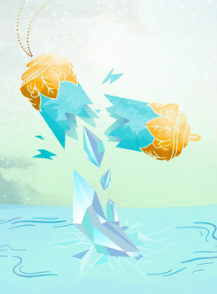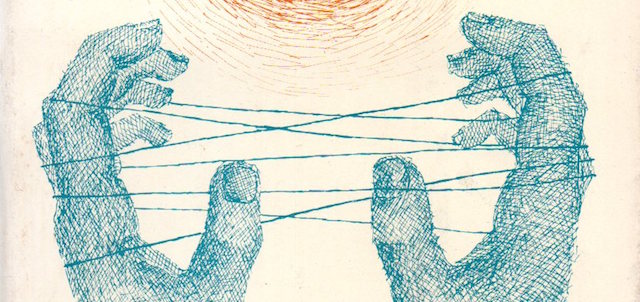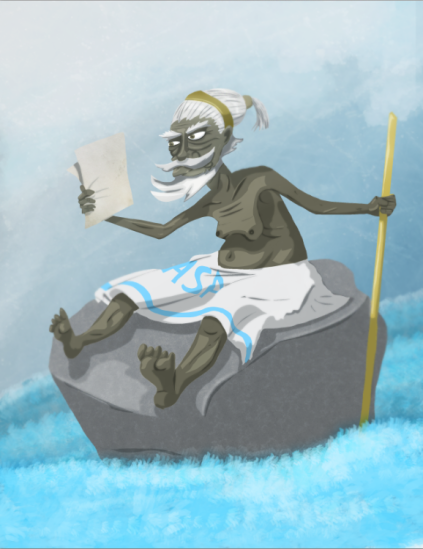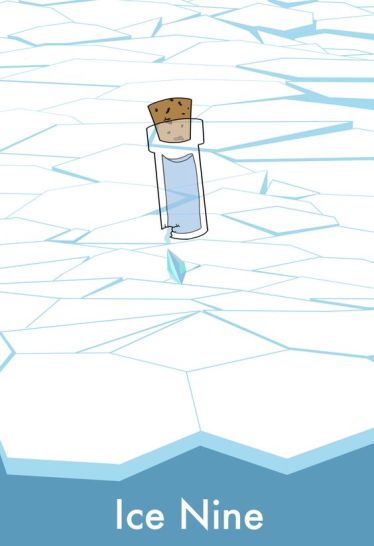I took Cat’s Cradle by Kurt Vonnegut to be an exaggerated tale about religion and the culture that surrounds it. Told through the lense of a born again Bokononist, the story follows a convoluted spiral to the end of days, so to speak. The book left me scratching my head thinking why.


The island of San Lorenzo acts as a contained Symbolic Code that reinforces the dominant cultural codes of the time. One of the main ones being the fight between science and religion, or some form of truth and lies. There are poor islanders, cruel and rich rulers, and an oppositional religion that everyone believes in (but openly denounces). These many cultural dynamics are as old as people, and are as important today as they were when the book was written. The beauty of Cat’s Cradle is that it is self-conscious and draws attention to its Symbolic Codes. Even the cruel leader “Papa” is a devout Bokononist, demanding on his deathbed to be given last rites; “I am a member of the Bokononist faith,” “Papa” wheezed. “Get out, you stinking Christian” (218).
This comes right after “Papa” demands that Jonah kill Bokonon saying, “He teaches the people lies and lies and lies” (218). Having read Philip Castle’s book on San Lorenzo, Jonah knows that the Bokonon religion is built on lies and opposition between the city and the jungle. Yet still Jonah says, “I was not eager to kill anyone” (218). This symbolic code between the oppressive government and something to believe in is what kept the San Lorenzo people going. Their secret belief in Bokononism made life on the terrible island tolerable. Bokonon continually preached; “‘Live by the foma that makes you brave and kind and healthy and happy.’ The Books of Bokonon. I: 5” (epigraph).
Yet in the end these foma (harmless untruths) lead the survivors on San Lorenzo to commit suicide. How can the foma then be harmless? How can commiting sucide make “you brave and kind and healthy and happy”? I feel that the lies of Bokononism had become dangerous by this point. They no longer served their purpose in creating a utopia as I thought Johnson and McCabe had desired.

The use of religion to create happiness in this text bothers me. Instead of actually increasing the standard of living on San Lorenzo, Bokonon created a religion to relieve the people of their suffering. Yet they still suffered, and in a negative turn of events some even died on the hook for their beliefs. Vonnegut laid bare centuries of turmoil due to poor living conditions and mixed religious teachings in such a way that it was comical, and outrageous. He wrote the symbolic code as if he was explaining it to the reader, rather than only existing within it. He called attention to the frame his narrative lived in, creating an interruption to the mimetic experience of the readerly text, yet somehow still creating a mimetic experience. By creating a false religion that was aware of its lies, the reader is forced to look at their own religion (which is taught as truth) and question how truthful it really is.

I think, like Campbell’s argument in Impacts of Science on Myth, the literal interpretation of Bokononism gets in the way of the spiritual impact it can have on people. In the end the dominant cultural code prevails. People have died for both science and religion and will continue to do so until ice-nine destroys the world, and in most cases even after that too. In the end religion killed the people and science killed the world. What is left for us to believe in?


Hey Nicole!
I like how you incorporated what we learned about cultural codes in your blog post. Its something I need to go back and make sure I place within my blog, so people are not confused with what I am talking about. I have never heard of the book Cat’s Cradle, so I was slightly confused, but my confusion was mainly ignorance of knowing nothing about the novel. Your blog post has intrigued me to read the book, because I am interested to see these views on religion played out within the story. I really need to know what Ice-Nine is, because it seems to cause so many conflicts within the story. Overall great blog post! I know I didn’t contribute much, but your blog post helped me identify certain things I need to revise within my own.
LikeLike
From the understanding of the text you have provided, it seems that you entered the text as a reluctant reader. Similar to how hesitant people enter religion in general, the narrative must have taken into account that there would be readers that would oppose the text’s controlling value supporting religion.
Yes, our cultural code in 2017 supports science over religion, but this text was published in 1963, meaning we have to look at the rhetorical context of the piece. This symbolic code was pointing towards religion being their fallback the entire time, as people in 1963 would have popularly supported during that time. So, perhaps being a hesitant reader is common when reading from our time, however, if you want to experience the aesthetic emotion of the text, the reader will have to understand and accept the cultural code of the time.
LikeLike
Religion and science are two opposing ideas present. Cat’s Cradle, from what I have read in your blog, is reinforcing and arguing the Cultural Code. This is something that is already known which “speaks the familiar ‘truths’” (Silverman 242). Something to grapple with this is the irony behind the cultural code and the “untruths” you talk about (foma). This leads me to believe the Symbolic Code is also present. Which is the truth and which is the lie? This structures and reinforces the dominant cultural codes of what we “already know”. The lies of Bokononism are essentially, the untruth. It seems as though this story is mastering the effects of manipulation and conformity.
LikeLike
Great job breaking down the text and presenting examples of where the semic code appears in the text. For my reply I decided to focus on the proairetic code. This code is responsible for the cause and effect sequence of the narrative that assists the readers to predict what will happen next. On P.146, we see that “Papa” collapses on stage during the “welcoming” of Jonah and the other guests. He begins mouthing a few words to Frank, but it is not until someone puts a microphone to his lips, that we can understand what he is saying.
“ You,” he said to Frank hoarsely, “you- Franklin Hoenikker- you will be the next president of San Lorenzo. Science- you have science. Science is the strongest thing there is.”
Then, on P.161 Frank calls Jonah at the hotel he is staying at and sounds breathless and scared.
“Listen! You’ve got to come out to my house right away. We’ve got to have a talk! It could be a very important thing in your life!”
In the pages that follow we see that Frank does not show up to the house until later that night. The suspense of wondering what Frank wants to tell Jonah not only intensifies for Jonah himself, but us as the reader. However, we are able to predict that Frank may be asking Jonah to become the next president. Numerous times throughout the text, we are reminded that Frank was considered to be a bit odd and not great with others. ie..
P. 23 “You know – he was always acting like he was on his way between two secret places; couldn’t ever talk to anybody. “
“Maybe he really did have a very rich secret life,” I suggested.
“Nah.”
“Nah,” sneered the bartender. “He was just one of those kids who made model airplanes and jerked off all the time.”
And again on P. 194 (right before Frank asks Jonah to be president).
About this Franklin Hoenikker- the pinch-faced child spoke with timbre and conviction of a kazoo. I had heard it said in the Army that such and such a man spoke like a man with a paper rectum. Such a man was General Hoenikker. Poor Frank had had almost no experience in talking to anyone, having spent a furtive childhood as Secret Agent X-9.”
LikeLike
Nicole, this was a very nice post. it was very detailed and flowed nicely.
I would watch out not to assume that the audience knows everything in the book, so when you mention Philip Castle and his book, you should probably say who he is and what his book’s title is (and relation to Jonah). Also, I noticed you forgot a few commas.
For the codes themselves, I have an idea for the Semic code, which Kopp described as, “Defines characters, objects, and places through repetitively grouping a number of signifiers (“semes”: words and phrases) around a proper name.”
Bokonon, the creator of the religion, has multiple semes associated with him:
-Bokonon writes (pg2),
-Bokonon invites us (pgs 3, 92)
Bokonon doesn’t have any type of epithet like, “The Great” or “The Wise”, so the book doesn’t imply that he is a great person. All that he says are lies. But, having words like “writes” and “invites” gives the idea that Bokonon is still a leader, someone that people listen to. The way that Jonah writes about him, it’s almost like Bokonon is a cult leader. What he says is not true, but people still choose to follow what he says.
– Alex
LikeLike
First of all, using Barthe’s explanation of the textual codes as a means of finding the cultural connections of a text is something I didn’t think about much, so thank you for bringing that to my attention. Considering the time period that the book itself was written in, this brings many things to light that are worth thinking about regarding what was accepted vs. taboo back then. As such, this gives us as the readers an overview of the author’s intended ideas and arguments far more clearly.
More importantly, perhaps, this draws even more attention to the fact that many of the issues, if not all of them, present in the book as a form of satire are still highly relatable today because, well, they still are problems. Especially with current events, more people than ever are seeking alternative forms of comfort, and while a suicidal religion is nothing to scoff at, the current opioid crisis is on a whole different level, yet stems from the same issue: escapism.
LikeLike